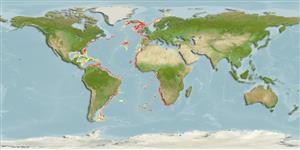Common names from other countries
Classification / Names / Names
Nomi Comuni | Sinonimi | Catalog of Fishes (gen., sp.) | ITIS | CoL | WoRMS
Environment: milieu / climate zone / depth range / distribution range
Ecologia
; distribuzione batimetrica 400 - 1230 m (Ref. 97531). Tropical
Eastern Atlantic: from southwest Sahara to Namibia.
Length at first maturity / Size / Peso / Age
Maturity: Lm ? range ? - ? cm Max length : 16.7 cm TL maschio/sesso non determinato; (Ref. 434)
Benthic or benthopelagic (Ref. 97531). Inhabits waters over muddy sand bottoms of the continental slope at depths from 500 to 1100 m. Carnivorous (Ref. 434).
Life cycle and mating behavior
Maturità | Riproduzione | Deposizione | Uova | Fecundity | Larve
Members of the order Decapoda are mostly gonochoric. Mating behavior: Precopulatory courtship ritual is common (through olfactory and tactile cues); usually indirect sperm transfer.
Fischer, W., G. Bianchi and W.B. Scott (eds.). 1981. (Ref. 434)
IUCN Red List Status (Ref. 130435)
CITES status (Ref. 108899)
Not Evaluated
Not Evaluated
Human uses
| FishSource |
Strumenti
Informazioni ulteriori
Age/SizeAccrescimentoLength-weightLength-lengthMorfologiaLarveAbbondanza
Fonti Internet
Estimates based on models
Preferred temperature
(Ref.
115969): 4.3 - 7.3, mean 5.8 (based on 34 cells).
Vulnerability
Low vulnerability (10 of 100).
Price category
Unknown.
